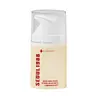What's inside
What's inside
 Key Ingredients
Key Ingredients

 Benefits
Benefits

 Concerns
Concerns

 Ingredients Side-by-side
Ingredients Side-by-side

Helianthus Annuus Seed Oil
EmollientVegetable Oil
Skin ConditioningAscorbic Acid 15%
AntioxidantPolyglyceryl-2 Triisostearate
EmulsifyingDiisostearyl Malate
EmollientCetyl Ethylhexanoate
EmollientCeresin
Emulsion StabilisingDipentaerythrityl Hexahydroxystearate/Hexastearate/Hexarosinate
Skin ConditioningHexyldecyl Ethylhexanoate
EmollientBeeswax
Emulsion StabilisingEuphorbia Cerifera Wax
Dipropylene Glycol
HumectantShorea Robusta Seed Butter
EmollientSucrose Tetrastearate Triacetate
EmollientParfum
MaskingCaprylyl Glycol
EmollientCopernicia Cerifera Wax
Hippophae Rhamnoides Oil
EmollientEthylhexylglycerin
Skin ConditioningGlycyrrhiza Uralensis Extract
EmollientTocopheryl Acetate
AntioxidantAdenosine
Skin ConditioningWater
Skin ConditioningButylene Glycol
HumectantHydrolyzed Collagen 0%
EmollientPanthenol
Skin Conditioning1,2-Hexanediol
Skin ConditioningAcetyl Hexapeptide-8
HumectantCopper Tripeptide-1
Skin ConditioningPalmitoyl Pentapeptide-4
Skin ConditioningOligopeptide-1
Skin ConditioningOligopeptide-2
Skin ConditioningHelianthus Annuus Seed Oil, Vegetable Oil, Ascorbic Acid 15%, Polyglyceryl-2 Triisostearate, Diisostearyl Malate, Cetyl Ethylhexanoate, Ceresin, Dipentaerythrityl Hexahydroxystearate/Hexastearate/Hexarosinate, Hexyldecyl Ethylhexanoate, Beeswax, Euphorbia Cerifera Wax, Dipropylene Glycol, Shorea Robusta Seed Butter, Sucrose Tetrastearate Triacetate, Parfum, Caprylyl Glycol, Copernicia Cerifera Wax, Hippophae Rhamnoides Oil, Ethylhexylglycerin, Glycyrrhiza Uralensis Extract, Tocopheryl Acetate, Adenosine, Water, Butylene Glycol, Hydrolyzed Collagen 0%, Panthenol, 1,2-Hexanediol, Acetyl Hexapeptide-8, Copper Tripeptide-1, Palmitoyl Pentapeptide-4, Oligopeptide-1, Oligopeptide-2
Water
Skin ConditioningCetyl Ethylhexanoate
EmollientGlycerin
HumectantButylene Glycol
Humectant1,2-Hexanediol
Skin ConditioningNiacinamide
SmoothingPropanediol
SolventAmmonium Acryloyldimethyltaurate/Vp Copolymer
Carbomer
Emulsion StabilisingTromethamine
BufferingSodium Acrylate/Sodium Acryloyldimethyl Taurate Copolymer
Emulsion StabilisingPolyisobutene
Caprylic/Capric Triglyceride
MaskingLactobacillus
Skin ConditioningLactobacillus/Rice Ferment
Skin ConditioningLactobacillus/Soybean Ferment Extract
Skin ConditioningMacadamia Ternifolia Seed Oil
EmollientSaccharomyces/Coix Lacryma-Jobi Ma-Yuen Seed Ferment Filtrate
Skin ConditioningSaccharomyces/Potato Extract Ferment Filtrate
HumectantXanthan Gum
EmulsifyingHydrogenated Lecithin
EmulsifyingDisodium EDTA
Ethylhexylglycerin
Skin ConditioningAllantoin
Skin ConditioningCaprylyl Glycol
EmollientAdenosine
Skin ConditioningGlyceryl Acrylate/Acrylic Acid Copolymer
HumectantCaprylyl/Capryl Glucoside
CleansingCholesterol
EmollientPolyglyceryl-10 Oleate
Skin ConditioningSorbitan Oleate
EmulsifyingBrassica Campestris Sterols
EmollientPhytosteryl/Behenyl/Octyldodecyl Lauroyl Glutamate
Skin ConditioningRetinal
Skin ConditioningSilica
AbrasiveAluminum/Magnesium Hydroxide Stearate
Emulsion StabilisingTocopherol
AntioxidantPotassium Cetyl Phosphate
EmulsifyingPentaerythrityl Tetra-Di-T-Butyl Hydroxyhydrocinnamate
AntioxidantArctium Lappa Root Extract
Skin ConditioningCnidium Officinale Root Extract
Skin ConditioningDioscorea Japonica Root Extract
Skin ConditioningPaeonia Suffruticosa Root Extract
Skin ProtectingRehmannia Chinensis Root Extract
Skin Conditioning3-O-Ethyl Ascorbic Acid
Skin ConditioningBakuchiol
AntimicrobialSh-Oligopeptide-1
Skin ConditioningSh-Oligopeptide-2
Skin ConditioningSh-Polypeptide-1
Skin ConditioningWater, Cetyl Ethylhexanoate, Glycerin, Butylene Glycol, 1,2-Hexanediol, Niacinamide, Propanediol, Ammonium Acryloyldimethyltaurate/Vp Copolymer, Carbomer, Tromethamine, Sodium Acrylate/Sodium Acryloyldimethyl Taurate Copolymer, Polyisobutene, Caprylic/Capric Triglyceride, Lactobacillus, Lactobacillus/Rice Ferment, Lactobacillus/Soybean Ferment Extract, Macadamia Ternifolia Seed Oil, Saccharomyces/Coix Lacryma-Jobi Ma-Yuen Seed Ferment Filtrate, Saccharomyces/Potato Extract Ferment Filtrate, Xanthan Gum, Hydrogenated Lecithin, Disodium EDTA, Ethylhexylglycerin, Allantoin, Caprylyl Glycol, Adenosine, Glyceryl Acrylate/Acrylic Acid Copolymer, Caprylyl/Capryl Glucoside, Cholesterol, Polyglyceryl-10 Oleate, Sorbitan Oleate, Brassica Campestris Sterols, Phytosteryl/Behenyl/Octyldodecyl Lauroyl Glutamate, Retinal, Silica, Aluminum/Magnesium Hydroxide Stearate, Tocopherol, Potassium Cetyl Phosphate, Pentaerythrityl Tetra-Di-T-Butyl Hydroxyhydrocinnamate, Arctium Lappa Root Extract, Cnidium Officinale Root Extract, Dioscorea Japonica Root Extract, Paeonia Suffruticosa Root Extract, Rehmannia Chinensis Root Extract, 3-O-Ethyl Ascorbic Acid, Bakuchiol, Sh-Oligopeptide-1, Sh-Oligopeptide-2, Sh-Polypeptide-1
Ingredients Explained
These ingredients are found in both products.
Ingredients higher up in an ingredient list are typically present in a larger amount.
1,2-Hexanediol is a synthetic liquid and another multi-functional powerhouse.
It is a:
- Humectant, drawing moisture into the skin
- Emollient, helping to soften skin
- Solvent, dispersing and stabilizing formulas
- Preservative booster, enhancing the antimicrobial activity of other preservatives
Adenosine is in every living organism. It is one of four components in nucleic acids that helps store our DNA.
Adenosine has many benefits when used. These benefits include hydrating the skin, smoothing skin, and reducing wrinkles. Once applied, adenosine increases collagen production. It also helps with improving firmness and tissue repair.
Studies have found adenosine may also help with wound healing.
In skincare products, Adenosine is usually derived from yeast.
Learn more about AdenosineButylene Glycol (or BG) is used within cosmetic products for a few different reasons:
Overall, Butylene Glycol is a safe and well-rounded ingredient that works well with other ingredients.
Though this ingredient works well with most skin types, some people with sensitive skin may experience a reaction such as allergic rashes, closed comedones, or itchiness.
Learn more about Butylene GlycolCaprylyl Glycol is a humectant and emollient, meaning it attracts and preserves moisture.
It is a common ingredient in many products, especially those designed to hydrate skin. The primary benefits are retaining moisture, skin softening, and promoting a healthy skin barrier.
Though Caprylyl Glycol is an alcohol derived from fatty acids, it is not the kind that can dry out skin.
This ingredient is also used as a preservative to extend the life of products. It has slight antimicrobial properties.
Learn more about Caprylyl GlycolCetyl Ethylhexanoate is an emollient ester. It comes from cetearyl alcohol and 2-ethylhexanoic acid.
Cetyl Ethylhexanoate is an emollient that adds a velvety feel to skin without being greasy or oily. Emollients help trap moisture into your skin, keeping your skin soft and hydrated.
Ethylhexylglycerin (we can't pronounce this either) is commonly used as a preservative and skin softener. It is derived from glyceryl.
You might see Ethylhexylglycerin often paired with other preservatives such as phenoxyethanol. Ethylhexylglycerin has been found to increase the effectiveness of these other preservatives.
Water. It's the most common cosmetic ingredient of all. You'll usually see it at the top of ingredient lists, meaning that it makes up the largest part of the product.
So why is it so popular? Water most often acts as a solvent - this means that it helps dissolve other ingredients into the formulation.
You'll also recognize water as that liquid we all need to stay alive. If you see this, drink a glass of water. Stay hydrated!
Learn more about Water